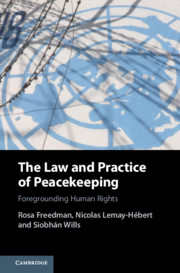Book contents
- The Law and Practice of Peacekeeping
- The Law and Practice of Peacekeeping
- Copyright page
- Contents
- 1 Introduction
- 2 A Political History of UN Involvement in Haiti
- 3 Integrating Human Rights Norms into UN Peacekeeping Practice
- 4 UN Immunities and Human Rights
- 5 The Cholera Epidemic
- 6 Sexual Exploitation and Abuse
- 7 UN Peacekeepers’ Use of Deadly Force to Maintain Law and Order
- 8 Conclusion
- Index
3 - Integrating Human Rights Norms into UN Peacekeeping Practice
Published online by Cambridge University Press: 28 May 2021
- The Law and Practice of Peacekeeping
- The Law and Practice of Peacekeeping
- Copyright page
- Contents
- 1 Introduction
- 2 A Political History of UN Involvement in Haiti
- 3 Integrating Human Rights Norms into UN Peacekeeping Practice
- 4 UN Immunities and Human Rights
- 5 The Cholera Epidemic
- 6 Sexual Exploitation and Abuse
- 7 UN Peacekeepers’ Use of Deadly Force to Maintain Law and Order
- 8 Conclusion
- Index
Summary
Peacekeeping today commonly involves large numbers of heavily armed troops mandated to use ‘all necessary means’ to carry out a wide range of tasks, often in densely populated and poorly resourced urban neighbourhoods. One function of international human rights law (IHRL) is to ensure that those who exercise power do so in accordance with the international standards established to protect human rights; however, it remains a relatively new development in international law that has advanced gradually, and as a result its integration into UN law and practice has been incremental and piecemeal. This chapter will discuss the development of human rights protection as a core UN goal and the Organisation’s inadequate attempts to entrench IHRL standards into peacekeeping theory and practice.
- Type
- Chapter
- Information
- The Law and Practice of PeacekeepingForegrounding Human Rights, pp. 34 - 47Publisher: Cambridge University PressPrint publication year: 2021

